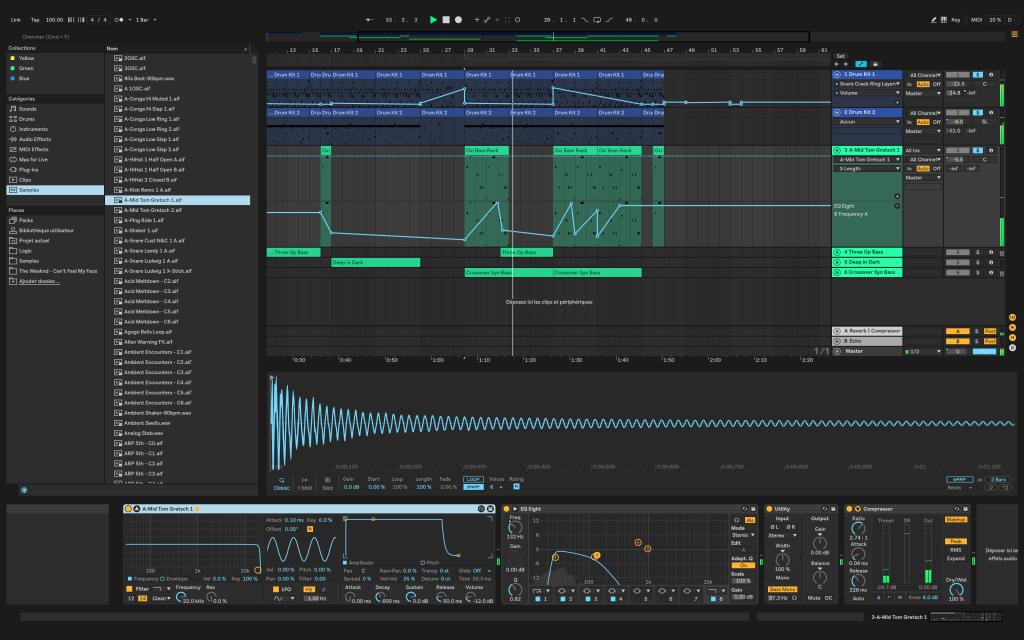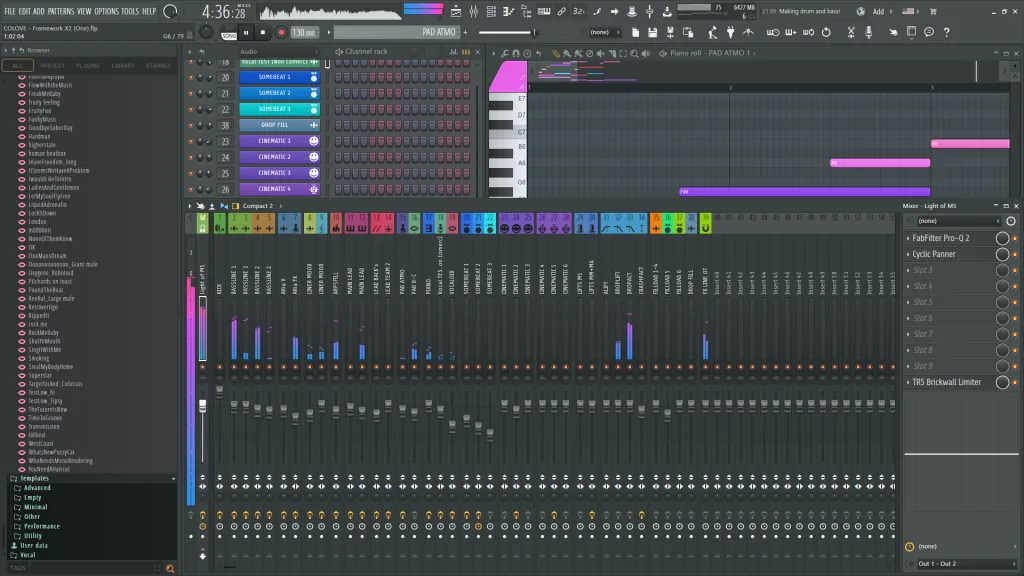having a hard time finding good vocals?
When it comes to choosing a Digital Audio Workstation (DAW) in 2024, the decision often boils down to a key question: Ableton vs FL Studio, which one is for you?
The choice of your DAW (Digital Audio Workstation) can be a pivotal decision for any producer, whether amateur or professional. Two names consistently stand out in this area: Ableton Live and FL Studio. Each offers a unique blend of features, workflow and creative potential, making the decision anything but easy.
As we dive into 2024, the debate between Ableton and FL Studio remains as relevant as ever. With this comprehensive comparison, we aim to dissect the intricacies of each DAW, shedding light on their strengths and weaknesses.
When comparing Ableton and FL Studio, the user interface (UI) and design aspects play a pivotal role in shaping the user experience. In 2024, both DAWs have evolved, but their core design philosophies remain distinct, appealing to different types of artists and producers.
Ableton Live’s interface is known for its streamlined and minimalist design. It’s engineered for efficiency and ease of navigation, making it a favorite among producers who prefer a straightforward, clutter-free workspace. The simplicity of Ableton’s UI is particularly advantageous during live performances, where quick access and reliability are paramount. Its Session View, a unique feature that sets it apart, allows for an innovative approach to music creation, letting users launch clips and experiment with arrangements in real-time.

Interestingly, Ableton allows users to customize the look of their workspace to some extent. It’s possible to download themes and color schemes, which can alter the accent color and contrast. However, these customizations are generally subtle, focusing more on fine-tuning the workspace rather than overhauling it.
In contrast, FL Studio is known for its vibrant and graphically rich interface. It’s a playground of color and creativity, inspiring producers who are visually driven. The interface is more graphic-intensive which may increase CPU and RAM usage, but it compensates with a visually engaging experience. Its Piano Roll is highly praised, offering an intuitive and comprehensive tool for MIDI editing and creative composition.

With a recent update, FL Studio has taken a significant step in customization by introducing themes. This new feature allows users to personalize their workspace, giving them the option to choose from a variety of themes and handpick any color, from primary to secondary and much more. This adds a bit more variety to the customization options compared to Ableton.
The quality and variety of stock plugins and instruments are critical factors in choosing the right software, especially for amateur producers. Both Ableton and FL Studio bring their unique strengths to the table in this regard offering a range of tools that cater to various production needs.
Ableton Live is renowned for its high-quality stock plugins and instruments. Its suite boasts a range of versatile tools that are both powerful and intuitive. Key highlights include synths like Analog and Operator, which are favored for their sonic clarity and ease of use. Ableton’s effects range, including reverb, EQ, and complex modulation tools, is user-friendly yet deeply customizable. The suite emphasizes quality, catering to various production styles from electronic music to traditional compositions.
FL Studio, on the other hand, is celebrated for the sheer abundance of its offerings. It offers a wide range of native VST instruments and various audio and MIDI effects plugins. Highlights are Sytrus, a versatile FM/wavetable synth, and Gross Beat, popular for time and volume manipulation in electronic and hip-hop. FL Studio aims to give producers a vast toolkit for sound exploration and experimentation.
The choice between Ableton vs. FL Studio in terms of stock plugins and instruments boils down to a preference for depth versus breadth. Ableton offers a carefully curated selection of high-quality tools that prioritize versatility and ease of use. FL Studio, with its extensive array of plugins and instruments, provides a more exploratory environment that encourages creative experimentation.
Whether you are a producer looking for a comprehensive set of tools to experiment with, or one who prefers a streamlined set of high-quality instruments and effects, your choice between Ableton and FL Studio will significantly influence your production capabilities and style.
The workflow and production process are critical aspects of any Digital Audio Workstation, greatly influencing the efficiency and creativity of music production. Ableton Live and FL Studio, while both powerful in their own right, offer distinct experiences in this domain.
The DAW is praised for its streamlined workflow, making it a go-to choice for many professional producers, especially in live performance settings. Its intuitive design allows for quick navigation and manipulation of tracks. The Session View is a standout feature here, offering a unique approach to arranging and remixing music on the fly. This non-linear workflow is ideal for improvisation and experimentation, allowing producers to spontaneously create and modify arrangements in real-time.
Additionally, features like audio effect racks, drag-and-drop functionality, and the ability to save custom effect chains enhance workflow efficiency, making complex processes more straightforward and accessible.
Additionally, the use of automations and stock plugins simplifies navigation, eliminating the need to open any pop-up windows.
FL Studio offers a workflow that is highly flexible and creativity-centric. Its pattern-based sequencing and robust Piano Roll make it a favorite for composers and producers who delve deeply into MIDI programming. The DAW’s modular interface, allowing for detachable and resizable windows, caters to a diverse range of production styles and preferences. For producers who prefer a hands-on approach to music creation, FL Studio’s workflow accommodates beat-making and detailed sound design.
While it may have a steeper learning curve initially, its versatility and depth are highly rewarding for those who invest the time to master it. However, it’s worth noting that many tasks in FL Studio typically require three times more clicks than in Ableton, leading to repetitive tasks in a professional’s daily workflow. Additionally, the playlist in FL Studio can become disorganized rapidly, mainly due to its non-traditional DAW layout.
The learning curve of a Digital Audio Workstation (DAW) is a crucial factor for both newcomers to music production and experienced producers exploring new software. Ableton Live and FL Studio, while both comprehensive in their capabilities, present distinct learning experiences.
With its streamlined interface and powerful features, Ableton can initially present a steep learning curve, especially for those new to music production. However, this complexity is a testament to its depth and versatility. Mastering Ableton leads to a seamless workflow, rewarding producers who invest time in learning its nuances. Its logical layout, once understood, enables quick, efficient music production. This makes it a favored choice among professionals, especially in live performance settings.
FL Studio is often perceived as more beginner-friendly, thanks to its intuitive design, especially in areas like the Piano Roll and the step sequencer. These features make it easier for beginners to start creating music without extensive knowledge of the software. However, this does not mean FL Studio lacks depth. FL Studio’s extensive features and flexible workflow offer a deep, enriching experience for users exploring its advanced capabilities. Its hands-on approach to music creation is highly valued by producers who prefer a tactile experience in their workflow.
Your choice between Ableton and FL Studio should consider your learning style and intended DAW use. Choose Ableton Live for a straightforward, efficient tool if you’re ready for an initial steeper learning curve leading to a streamlined experience later on. Alternatively, FL Studio is great if you’re beginning or want an intuitive start with potential for complexity as you advance.
Previously, FL Studio’s numerous tutorials aided many producers in learning and developing their skills. Recently, however, educational content for Ableton, especially in EDM, has grown substantially, now matching or surpassing FL Studio’s resources. For Hip Hop and beatmaking, FL Studio continues to be a popular choice among producers in these genres.
As we reach the end of our comprehensive comparison between Ableton Live and FL Studio, it’s clear that the question of which DAW is the best doesn’t have a one-size-fits-all answer. Both platforms excel in their unique ways, catering to different needs, preferences, and production styles.
We at Voxalized do not only offer a way to get high-quality affordable vocals for your songs, but have also created a rating list to assist you in making your decision between Ableton vs. FL Studio.
| Features | Ableton | Fl Studio |
|---|---|---|
| Workflow | 8 / 10 | 5 / 10 |
| Easy of use | 6 / 10 | 7 / 10 |
| Tutorials | 10 / 10 | 10 / 10 |
| Price | 6 / 10 | 10 / 10 |
| Piano Roll | 7 / 10 | 9 / 10 |
| FX | 8 / 10 | 8 / 10 |
| Instruments | 6 / 10 | 7 / 10 |
| Recording | 7 / 10 | 4 / 10 |
| Live Perf. | 9 / 10 | 3 / 10 |
Ultimately, the choice between Ableton and FL Studio should be based on your personal production requirements, your workflow preferences and the kind of music you intend to create.
Ableton Live is known for its efficient workflow, intuitive live performance tools, and a user-friendly interface. This makes it perfect for efficient music production, live performances, and those who prefer a structured approach.
FL Studio excels with its creative, flexible environment, offering a wide range of plugins and instruments. Its interface fosters exploration and creativity, making it ideal for new producers, MIDI enthusiasts, and those seeking a visual experience.
If you want to have a look at other top-tier DAW’s, read our article about The Best DAWs of 2024: Find the Best DAW for Music Production.
Do you know how much money can you get from Spotify? Try our World’s #1 break-even calculator for artists to calculate it and help you in your financial decisions.
More to explore